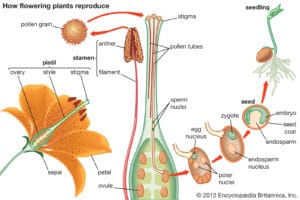To better understand how we can ensure that the seeds we collect will result in the plants that we want, let’s go back to high school biology and review plant reproduction basics!
The male parts of the flower are called the staman, made up of the anther and filament. The pollen sits on the anther waiting to be moved to the female part of the same or a different flower.
The female part of the flower are called the carpel made up of the stigma, style and ovary. Pollen lands on the stigma (this is pollination) moves down the style to find an ovule in the ovary (this is fertilization).
Some pollen is light and is presented on high anthers. Wind moves this pollen to female flowers and corn is a wonderful example. Some pollen is very sticky and needs an insect or other agent to move it to female flowers. This is true of goldenrod.

Is this starting to sound familiar? This is very basic and plants have evolved many tricks to make their pollen more available for pollination. Some plants have evolved with specific insect pollinators. Flowers, you may know, exist to assist the pollinator in finding the pollen. To a bee’s eyes some petals seem to have landing stripes leading straight to the pollen and nectar. It is a fascinating topic! The Community Seed Network has information on a few different pollination types.
For our purposes this basic model will work. Next time we will look at plant types: hybrid vs. open pollination.
Happy Gardening!
- ParSLAY the Day! - June 12, 2024
- 6th Annual Great Southeast Pollinator Census - May 28, 2024
- Are you ready for Pepper Palooza? - July 5, 2023